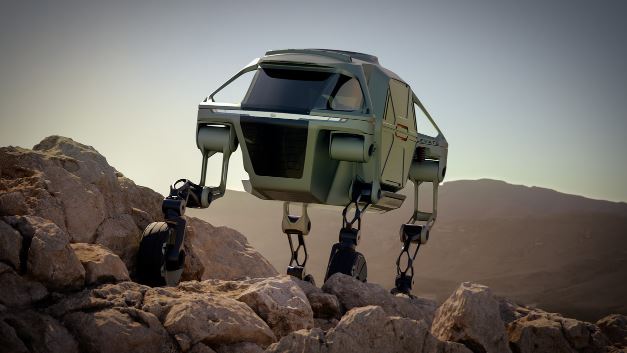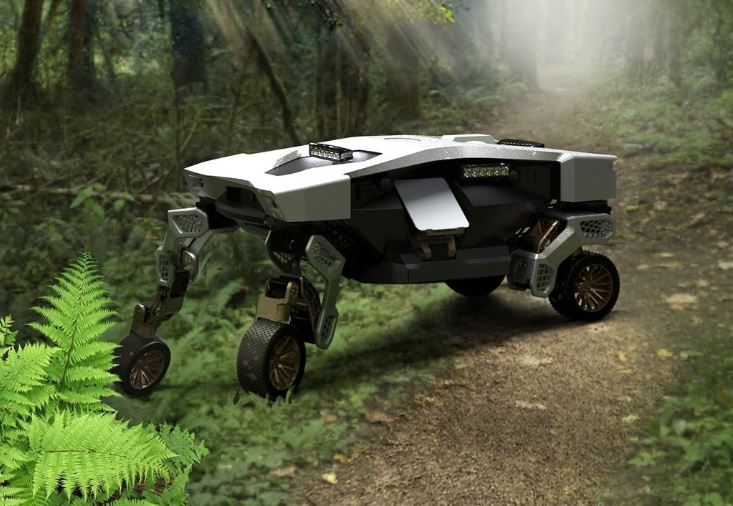Hyundai Walking Vehicle the Advancing the Future of Mobility
Hyundai Motor Group has achieved a significant milestone in its pursuit of developing futuristic four-legged cars by obtaining patents for walking vehicles in the United States. The US Patent and Trademark Office recently published two patent applications filed jointly by Hyundai and Kia on December 31, 2021.
These patents serve to protect the advanced technologies behind Hyundai’s concept car, Elevate. Elevate is an electric vehicle designed to seamlessly transition between conventional driving on flat surfaces using wheels and walking on challenging terrains with the help of robotic legs. The initial prototype of Elevate was unveiled by Hyundai at the Consumer Electronics Show in 2019. Showcasing the ability to imitate both mammalian and reptilian gaits, Hyundai positioned Elevate as a versatile vehicle suitable for exploration, construction, and disaster relief operations in environments where traditional roads are inaccessible.
Kim Pil-su, an automotive engineering professor at Daelim University, emphasized the importance of patent registrations as indicators of a company’s direction and its commitment to securing maximum protection for future products prior to commercialization. Hyundai Motor Group’s patent registration for walking vehicles positions the company as a pioneer in the specialized market of robot mobility, specifically designed to navigate unconventional terrains.
Lee Tae-hoon, a patent attorney, highlighted the significance of securing patents in multiple countries. The investment made by Hyundai in obtaining these patents indicates the technology’s importance and potential for commercialization.
The development of the Elevate concept was a collaborative effort between Hyundai Cradle, the automaker’s open innovation center, and Sundberg-Ferar, a US design company. To further advance their vision of ultimate mobility vehicles, Hyundai established New Horizons Studio in September 2020. This dedicated unit focuses on the development of Ultimate Mobility vehicles.

During the unveiling of the Elevate concept in 2019, John Suh, the then-head of Hyundai Cradle, emphasized its remarkable capabilities. He highlighted how Elevate could play a crucial role in rescue missions during tsunamis or earthquakes. While conventional rescue vehicles can only transport first responders to the edges of debris fields, leaving them to proceed on foot, Elevate has the unique ability to drive directly to the scene and navigate flood debris or damaged concrete by climbing walls and stepping over gaps.
According to Hyundai, Elevate can climb walls up to 1.5 meters high, step over gaps of the same height, and traverse various terrains at an average speed of 5 kilometers per hour while maintaining stability for passengers. When the robotic legs are retracted, and the wheels engage, Elevate can drive at high speeds like a conventional vehicle on regular roads.
Hyundai Motor Group has also made significant progress in the development of another transformative vehicle called the Transforming Intelligent Ground Excursion Robot, or TIGER. Unveiled by New Horizons Studio in February 2021, TIGER is a multi-purpose unmanned vehicle equipped with wheels on robotic legs, similar to Elevate. While Elevate focuses on passenger-carrying capabilities, TIGER is designed for a variety of applications.
Professor Kim highlighted Hyundai’s acquisition of Boston Dynamics in 2020, renowned for its four-legged robot dog Spot, as a significant advantage for the company in the field of walking robot technology. He expressed optimism about future collaboration between Hyundai and Boston Dynamics, as the combination of Hyundai’s expertise and Boston Dynamics’ advanced technology can lead to effective commercialization.
In his New Year’s speech to employees, Hyundai Motor Group Executive Chair Chung Euisun emphasized the importance of future mobility and robotics. He stated the company’s commitment to introducing purpose-built vehicles that cater to the transportation needs of both people and objects, reaffirming their dedication to driving innovation in the market.

